Search Results

- IDNO:
- 009687
- Title:
- Tanks and Loading Rack, Volcano, W. Va.
- Date:
- 1898
- Description:
- 'Tanks and loading rack at Volcano Junction. Here the Sand Hill and Laurel Fork Railroad met the Baltimore and Ohio. Both standard gauge tracks.'

- IDNO:
- 009691
- Title:
- Concrete Oil Tank, Volcano, W. Va.
- Description:
- 'Concrete oil tank, probably only one built. The remants of two tanks (concrete) are visible from the top of Petroleum Road. These tanks, and the one in this photo, appear to be water tanks. Water was needed for the steam engines. (Note the water in your tank) Oil tanks were either wood, or metal. The metal tanks could be moved from one site to another. When the gushers first came in there was labor unrest because the coopers were making more money than the oil workers-barrels could not be made fast enough to meet the demand.'--Mike Naylor, 03/2006
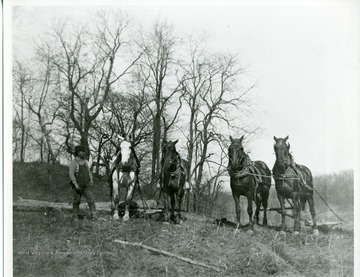
- IDNO:
- 009706
- Title:
- Oil Field Teamster and Team, Volcano, W. Va.
- Description:
- 'This fellow might be an oil field worker, but it appears that the horses are harnessed for plowing a field--note the location of device behind horse and furrowed field.'--Mike Naylor, 03/2006

- IDNO:
- 009707
- Title:
- Tank Car of the Zero Oil Company

- IDNO:
- 009708
- Title:
- Derricks in the Volcano Oil Field
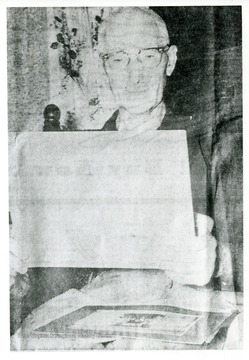
- IDNO:
- 009709
- Title:
- Railroad Man, Volcano, W. Va.
- Description:
- 'Hard to see on original print, but it looks like he's holding a newspaper. The gentleman worked on the Laurel Fork and Sand Hill Railroad. This picture comes from a Parkersburg Sentinel article chronicling his experience. Parkersburg News July 10, 1960, page 6.'--Mike Naylor, 03/2006.

- IDNO:
- 009710
- Title:
- Wood Derrick and Pump Station, Volcano, W. Va.
- Description:
- 'The horizontal boards on the pumping station are called walking beams. Walking beams converted the horizontal energy to vertical(up and down motion)energy to pull the oil to the surface. Volcano had two newspaper: a) Volcano Lubrication and b) West Virginia Walking Beam.'--Mike Naylor, 03/2006

- IDNO:
- 009711
- Title:
- Gas Engine, Volcano, W. Va.
- Description:
- "This huge gas engine is the source of power for the pumping of at least 25 oil wells in the Volcano area. Oil, once plentiful in the vicinity, has been used up to such an extent that production costs must be kept to a minimum by the use of cheap power. The engine power is transferred to the pumps by means of an endless cable.'--Back of photograph. 'William C. Stiles, Jr. introduced the endless cable pumping system in 1874. He did not invent the endless cable system but was the first to use it in the production of oil. The John Roebling Comapny (NY) manufactured the cable used. This same cable used when Roebling built the Brooklyn Bridge. Roebling's son, Washington Roebling, played a very keen role in the Union victory of Gettysburg. Roebling never bothered to protect their cable-consided it to be a bother. The large wheel in this photo is a band wheel. It transfers the power from the engine to the endless cable system. The belt shown is probably leather. The power is geared up by passing over three belted wheels. The last wheel have a diameter of 18 feet. The 18 foot wheel travel very slowly, but very powerfully. Form it the power transfered to the cable system.'--Mike Naylor, 03/2006.

- IDNO:
- 009722
- Title:
- Pump Station, Volcano, W. Va.
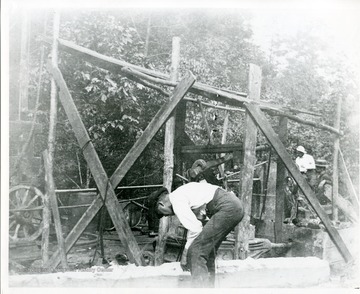
- IDNO:
- 009723
- Title:
- Spring Pole Drilling Rig, Volcano, W. Va.
- Description:
- 'Old spring pole drilling rig in the Volcano oil field. Taken shortly after the Civil War.'
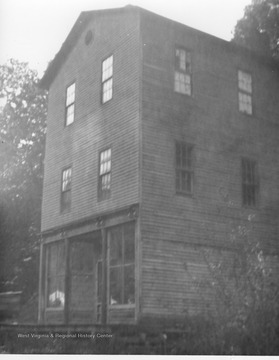
- IDNO:
- 009766
- Title:
- Store and Masonic Hall, Volcano, W. Va.
- Description:
- 'John Shaffer's Store which was still standing in 1953. Masonic Hall on the third floor still used in 1953.'
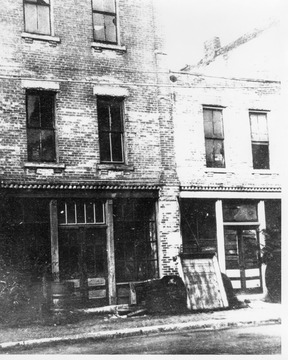
- IDNO:
- 009769
- Title:
- Stiles Oil Company Headquarters, Parkersburg, W. Va.
- Description:
- Stiles Oil Company Headquarters, First Street, Parkersburg, West Virginia.